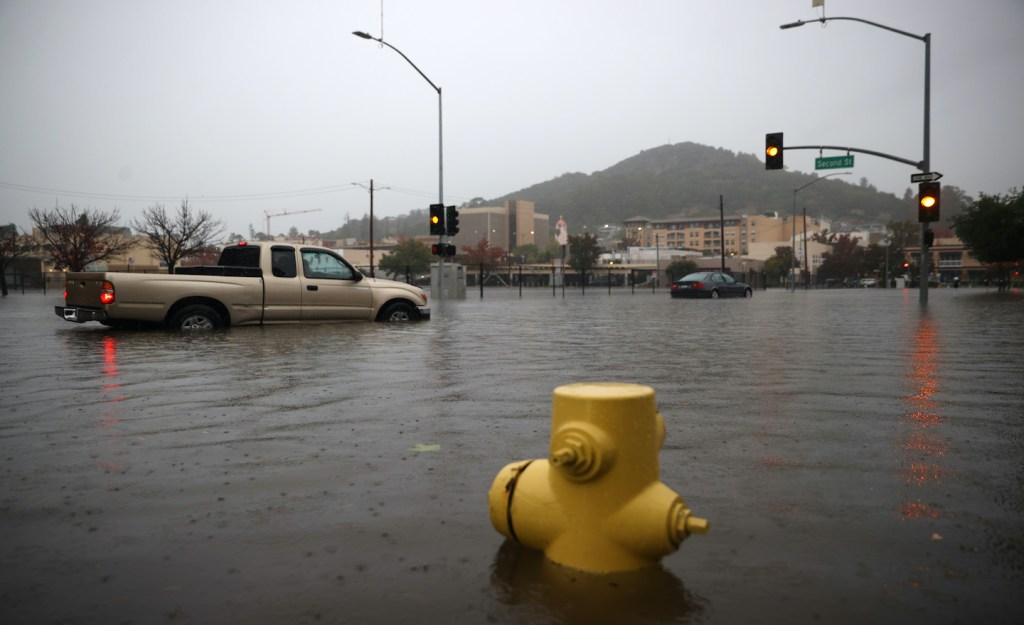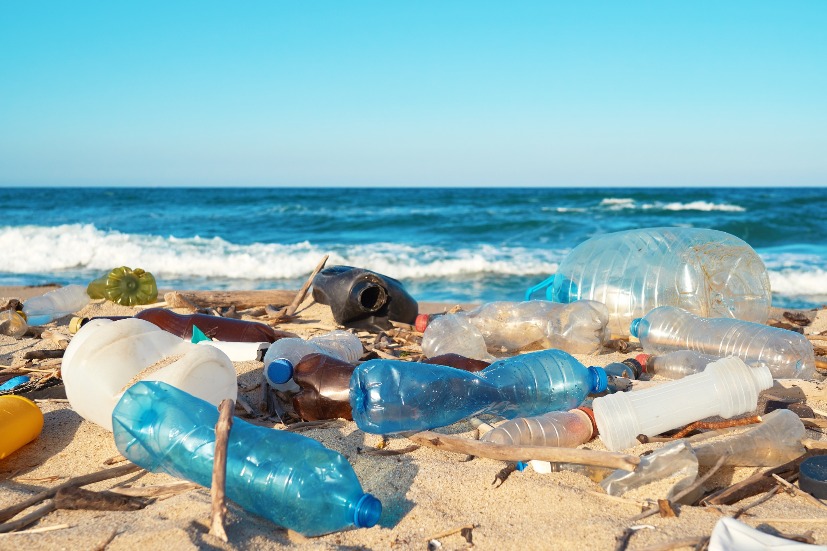Equilibrium/Sustainability — Presented by Southern Company — As International Space Station winds down, billionaires swoop in
Today is Tuesday. Welcome to Equilibrium, a newsletter that tracks the growing global battle over the future of sustainability. Subscribe here: digital-stage.thehill.com/newsletter-signup.
Blue Origin, the space venture owned by Jeff Bezos, has announced plans to build a commercial space station that will become operational later this decade, The Wall Street Journal reported.
The proposed facility, called Orbital Reef, will be the product of a private partnership among a unit of Sierra Nevada Corp., Boeing Co. and others, with the aim of generating revenue from both private-sector customers — like entertainment companies and manufacturers — and government agencies, according to the Journal. Blue Origin’s news follows other recent announcements about private space stations, including a facility by Axiom Space Inc. and another by Nanoracks, Voyager Space and Lockheed Martin Corp., called Starlab.
As private space labs begin to take off, NASA’s International Space Station — which costs up to $4 billion annually and will be structurally sound through 2028 — is planning to wind down operations, the Journal reported. Meanwhile, NASA will be awarding up to four contracts of at least $300 million to support commercially owned facilities in orbit. Blue Origin has filed a proposal to NASA, but intends to go forward with its plans regardless, according to the Journal.
Back on Earth, one of Bezos’s billionaire space frenemies, Elon Musk, declared that Hertz will not be getting a discount on a fleet of Teslas coming to the rental giant. Today we’ll look at how that massive order has raised Tesla’s value above that of every other carmaker combined — and further scrutinize the arrangement. Then we’ll turn our attention to the “atmospheric river” pummeling the West Coast.
For Equilibrium, we are Saul Elbein and Sharon Udasin. Please send tips or comments to Saul at selbein@digital-stage.thehill.com or Sharon at sudasin@digital-stage.thehill.com. Follow us on Twitter: @saul_elbein and @sharonudasin.
Let’s get to it.
Interpreting the Tesla spike

A mass order of Tesla Model 3s by rental company Hertz has driven Tesla’s value up above a trillion dollars — putting the electric car maker among the ranks of Apple, Amazon and Microsoft.
Tesla is also now valued above Facebook and more valuable than several major automakers combined, The Wall Street Journal reported.
That has investors asking: Is Tesla the next American tech giant, or is its rise a strange, hype driven bubble?
First steps: Tesla’s rise in valuation came from a jump in its stock prices following a $4 billion order of 100,000 Teslas by the troubled rental giant, whose new post-bankruptcy owners are billing it as part of a “new Hertz,” the Journal reported.
The pandemic’s slowdown in travel drove the company into Chapter 11 bankruptcy, which it discharged in part by selling off its fleet, Car and Driver reported.
Now it wants to replace much of that fleet with Teslas: up to 20 percent of its total by the end of 2022, the rental company reported.
The announcement drove Tesla stocks up to $1,024 a share — about 17 times where it was this time two years ago.
This unnerved even CEO Elon Musk. “Strange that moved valuation, as Tesla is very much a production ramp problem, not a demand problem,” Musk tweeted.
In other words: the question isn’t whether people will buy Teslas. It’s whether Tesla can build to the size and capacity of a mass automaker on the scale of Ford or Toyota.
A MESSAGE FROM SOUTHERN COMPANY
At Southern Company, we achieved our interim net zero energy goal ten years early. Today, we continue our work toward a net zero future.
DEBATING THE TESLA JUMP
Sales to rental car agencies are often a bad deal for big carmakers, because they tend to be sold after short periods of time with relatively few miles, The New York Times reported.
That allows today’s sale to be tomorrow’s gently-used secondhand, competing against and driving down the prices of new cars — one reason why luxury brands avoid selling to rental agencies, the Times reported.
And Tesla also has its own particular troubles. Elon Musk had to settle a charge of securities fraud with the Securities and Exchange Commission for $40 million; his company’s debt has a low credit rating; and its high valuation belies its low sales and earnings, according to a rundown in the Times’ Dealbook.
And while Tesla’s valuation is currently more than that of the largest carmakers combined, Tesla will soon face a more crowded market as other carmakers race to roll out their own new electric vehicle lines, Dealbook noted.
So does that high valuation make sense? The answer to that question comes down to whether Tesla is more like Ford, or more like Amazon.
One argument: It’s a car company. Tesla is doing a good job, “but this does not alter our view Tesla is egregiously overvalued,” Roth Capital Partners analyst Craig Irwin wrote, according to the Los Angeles Times.
That sky-high valuation, Irwin added, appears to rest on the “specious assumption that the hundreds of EVs slated for launch by 2025 will all be flops.”
In other words: unless you’re betting that Tesla is likely to hold the future auto market almost to itself, it doesn’t make sense for it to be worth over a trillion dollars.
Counterpoint: It’s a tech company — and this is only the beginning. But to more enthusiastic investors, the supply chain challenges and business opportunities of electric vehicles — a suite of technologies that include charging, logistics, remote sensing and computing — are much more like an Amazon than a Ford, even if both end up producing electric pickup trucks, as the Los Angeles Times reported.
Last words: “Tesla is the leader in EV manufacturing, batteries and autonomy,” Morgan Stanley analyst Adam Jonas wrote on Monday, according to the Times. “Tesla also has a suite of enabling technologies and other businesses that would allow the company to be an auto and energy champion in the long run.”
California deluge may be insufficient to curb drought

Two “atmospheric rivers” washing over Northern California over the past week have extinguished two of the state’s biggest wildfires while bringing much-needed water to dwindling reservoirs, The Wall Street Journal reported.
Yet while the Los Angeles Times described the storms as “music to the ears of Southern Californians” — who have long endured the worst of the statewide drought — experts told the Times that even a record-breaking storm may not be enough to quench California’s thirst.
What’s an atmospheric river? It’s a “thin, but long plume of moisture in the atmosphere that stretches from the tropics or subtropics into higher latitudes,” according to the Weather Channel. Atmospheric rivers can be so strong that they are capable of transporting, as water vapor, up to 15 times the flow of water at the mouth of the Mississippi River, the Weather Channel said.
And these particular atmospheric rivers? The first began ushering in heavy rains last Tuesday, while the second river — considered California’s biggest in more than a decade — slammed into the coast over the weekend and persisted through Monday, breaking rainfall records in San Francisco and Sacramento, the Journal reported.
That river, which triggered flooding and debris flows, also “became the strongest known northeast Pacific bomb cyclone on record” and brought heavy snow to the Sierra Nevada, another Weather Channel piece said.
A what? A “bomb cyclone,” according to The Washington Post, is “a storm that strengthens with unusual haste.” Not to be outdone by the West Coast, the ongoing East Coast nor’easter storm is soon expected to qualify as a bomb cyclone as well, and is “the final act of a destructive ensemble that brought tornadoes” on Sunday to the Midwest, the Post reported.
But back to California: The atmospheric rivers pummeling Northern California have brought an end to the Caldor Fire near Lake Tahoe, as well as the Dixie Fire near Lassen Volcanic National Park — both of which had yet to be fully contained since they broke out during the summer, according to the Journal.
Meanwhile, Lake Oroville, California’s second-biggest reservoir, rose more than 24 feet in the past week, while Folsom Lake, outside of Sacramento, rose 12 feet. These were some of the biggest deposits the state reservoirs have received in years, the Journal reported.
A MESSAGE FROM SOUTHERN COMPANY
At Southern Company, we achieved our interim net zero energy goal ten years early. Today, we continue our work toward a net zero future.
‘THERE’S NO QUICK FIX TO DROUGHT’
But the drought is far from over. Bill Patzert, a retired climate scientist at NASA’s Jet Propulsion Laboratory, told the Los Angeles Times that one rainy winter would be insufficient to pull California out of its arid state. He predicted that it would take 17 years of above-normal precipitation to refill Lake Mead, the largest reservoir on the Colorado River and a key water source for the West.
“There’s no quick fix to the drought,” Patzert told the Times.
Brad Pugh, a meteorologist at the National Oceanic and Atmospheric Administration, likewise told the Times that south of the Bay Area, the “prospects for any drought improvement are slim.”
Rapid transition from extreme dry to wet: Daniel Swain, a climate scientist at the University of California, Los Angeles, expressed little surprise in a tweet assessing California’s current weather conditions, posting a link to his 2018 Nature Climate Change article that explored how precipitation volatility in California has led to a “rapid transition from record multi-year dryness” to dramatic wintry wetness.
Anthropogenic forcing — human-caused climate drivers — can “yield large twenty-first-century increases in the frequency of wet extremes, including a more than threefold increase in sub-seasonal events comparable to California’s ‘Great Flood of 1862’,” the article concluded.
Last words: “It is worth noting that this exact situation — an extremely strong atmospheric river bringing [a] brief period of record rainfall in midst of severe and temperature-amplified drought — is what we expect to see in California with climate change,” Swain tweeted.
Tech Tuesday

Philippine startup transforms plastic from beach blight to building block
- The Philippines’s terrible problem with single-use plastic pollution — which clogs rivers and washes up on beaches — is providing the grist for a new kind of building material, Reuters reported.
- The Plaf, or The Plastic Flamingo, collects, shreds and presses plastic waste into an imitation wood paneling that can be used for fences or decking, according to Reuters.
- There is great global need for these sorts of products: 300 million metric tons of plastic waste are produced each year, according to the United Nations Environmental Program — which has surged due to pandemic-driven shipping and hygiene demands, Reuters reported.
- In a country with minimal recycling, The Plaf is aiming to convince consumers to stop putting plastic in landfills and oceans — or burning it — and instead bring it “to recycling centres like us and we would upcycle them into better products,” company marketing associate, Allison Tan, told Reuters.
Construction tech collaboration printing suburb in Austin outskirts
- A construction company and a tech company are collaborating on a new housing development outside of Austin that will be made up of 100 3D-printed houses — opening a path to what could become a new supply of affordable homes, The Wall Street Journal reported.
- The project will be a big jump in scale for Icon, the tech company doing the printing. “We’re sort of graduating from singles and dozens of homes to hundreds of homes,” Jason Ballard, Icon’s chief executive, told the Journal.
- Lennar, the construction company, hopes it can cut labor costs. “Skilled tradesmen are a dying breed, so there have to be alternative building solutions to help with this labor deficit,” Eric Feder, the president of Lennar’s venture capital and innovation unit, told the Journal.
Climate tech start-ups have raised record $32 billion this year
- Climate technology companies around the globe have raised a record-breaking $32 billion thus far in 2021, CNBC reported, citing a study from venture capital analysis firm Dealroom and promotional agency London & Partners.
- The amount of venture capital money invested in climate tech this year has already exceeded all such funds in 2020, while climate tech investments have quadrupled since 2016, according to CNBC.
- In the past five years, climate tech start-ups raised the most money in the U.S., followed by their peers in China, Sweden and the U.K., CNBC reported.
- Europe, meanwhile, is the fastest-growing region for climate tech — with venture capital investments into the sector seven times higher this year than in 2016, according to CNBC.
Please visit The Hill’s sustainability section online for the web version of this newsletter and more stories. Stay dry, and we’ll see you on Wednesday.{mosads}
Copyright 2023 Nexstar Media Inc. All rights reserved. This material may not be published, broadcast, rewritten, or redistributed. Regular the hill posts
Video/Hill.TV











